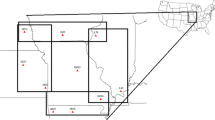Abstract
Nitrate (NO3−) and ammonium (NH4+) ions are important determinants of the ionic strength and pH of precipitation1. The deposition of these ions on vegetation and on the ground also constitutes a significant source of nutrients for plants. This is particularly the case in polluted regions, for example, Europe, where the deposition of nitrogen compounds is enhanced2. There are indications (for example, increased run-off of nitrogen3) that forests in some parts of Europe have reached saturation levels with respect to nitrogen deposition; and excessive wet and dry deposition of nitrogen compounds has been suggested as a possible cause of the extensive damage to forests in Europe4. Data from Rothamsted, UK, indicate that the mean concentration of NO3− in precipitation doubled between the 1850s and I960 (ref. 5); similarly, the NH4+ concentration probably increased between the 1880s and 1960. A review of precipitation chemistry data from Europe indicates an approximately threefold increase in NO3− deposition between the 1890s and the late 1970s6. The present analysis of data from the European Air Chemistry Network reveals that the NO3− concentration at most stations approximately doubled between the late 1950s and early 1970s, with a less pronounced increase in NH4+. Detailed analysis of data from 12 Swedish stations showed no further increase of NO3− or NH4+ between 1972 and 1984. In contrast, the sulphate concentration decreased by ∼30% for the same locations and time period.
Similar content being viewed by others
References
Granat, L. Tellus 24, 550–560 (1972).
Acidification Today and Tomorrow (Swedish Ministry of Agriculture, Stockholm, 1982).
Paces, T. Nature 315, 31–36 (1985).
Nihlgård, B. Ambio 14, 2–8 (1985).
Brimblecombe, P. & Pitman, J. Tellus 32, 261–267 (1980).
Brimblecombe, P. & Stedman, D. H. Nature 298, 460–461 (1982).
Eriksson, E. WMO Tech. Note 106, 31–54 (World Meteorological Organization, Geneva, 1970).
Rodhe, H., Söderlund, R. & Granat, L. Rep. CM-64 (Department of Meteorology, Univ. Stockholm, 1984).
Söderlund, R. & Granat, L. Rep. CM-59 (Department of Meteorology, Univ. Stockholm, 1982).
Söderlund, R., Granat, L. & Rodhe, H. Rep. CM-69 (Department of Meteorology, Univ. Stockholm, 1985).
Kallend, A. S., Marsh, A. R. W., Pickles, J. H. & Proctor, M. V. Atmos. Envir. 17, 127–137 (1983).
Horvath, L. Tellus 35, 304–308 (1983).
Granat, L., Söderlund, R. & Bäcklin, L. Rep. AC-40 (Department of Meteorology, Univ. Stockholm, 1977).
Rodhe, H. & Granat, L. Atmos. Envir. 18, 2627–2639 (1984).
Rep. PM 1879 (National Swedish Environment Protection Board, 1984). (In Swedish.)
The State of the Environment 1985 (Organization of Economic Cooperation and Development, Paris, 1985).
FRG 1984: Forest Damage Survey (Federal Ministry of Food, Agriculture and Forestry, Bonn, 1984).
Andersson, F. Water, Air and Soil Pollution (in the press).
Author information
Authors and Affiliations
Rights and permissions
About this article
Cite this article
Rodhe, H., Rood, M. Temporal evolution of nitrogen compounds in Swedish precipitation since 1955. Nature 321, 762–764 (1986). https://doi.org/10.1038/321762a0
Received:
Accepted:
Issue Date:
DOI: https://doi.org/10.1038/321762a0
- Springer Nature Limited
This article is cited by
-
Atmospheric Nutrient Input to the Baltic Sea from 1850 to 2006: A Reconstruction from Modeling Results and Historical Data
AMBIO (2012)
-
Isotopic characterization of atmospheric nitrogen inputs as sources of enhanced primary production in coastal Atlantic Ocean waters
Marine Biology (1994)
-
Urban wet deposition nitrate: A comparison to non-urban deposition
Water, Air, & Soil Pollution (1994)
-
Will an increased greenhouse impact in Fennoscandia give rise to more humic and coloured lakes?
Hydrobiologia (1992)
-
Seasonal variation of gaseous HNO3 and NH3 at a Tropical Savannah site
Journal of Atmospheric Chemistry (1990)





